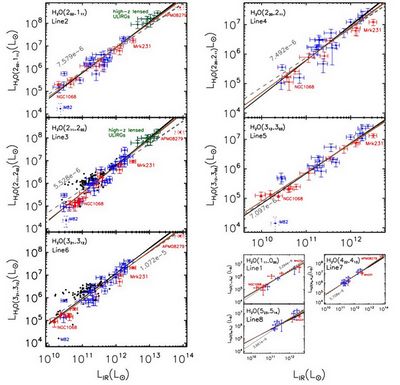Water molecule can be one of the most abundant oxygen molecular carriers besides CO in the warm interstellar gas. It traces various physical and chemical processes in the molecular clouds differently from the normal gas tracers like CO and HCN, thus can tell us very unique information about the galaxies. Nevertheless, the study of the rotational H2O lines is always far more challenging than CO at low redshift. 
Fig. 1.Correlation between LH2O and the corresponding LIR of our sample. The fitted lines by MPFIT and LINMIX_ERR are shown in black and brown lines, respectively, while the gray lines are the linear fitting with a fixed slope (α = 1). The red, blue, green, and black dots represent strong-AGN, Hii+mild-AGN-dominated galaxies, high-z ULIRGs, and the upper limits for non-detections, respectively. The solid triangles are the mapping mode data of NGC 1068. Mrk231 is marked in red squares. M82 and APM08279+5255, marked with dashed error bars, are excluded from the fitting. By with YANG Chentao Recently, YANG Chentao , Dr. GAO Yu and their collaborators from worldwide reported the first systematic study of the submillimeter H2O rotational emission lines in infrared (IR) galaxies based on the Fourier Transform Spectrometer (FTS) data of Herschel SPIRE. Among the 176 galaxies with publicly available FTS data, 45 have at least one H2O emission line detected. In addition, they also found emission lines of H2O+ and H218O in the sample. They discovered that H2O, for most galaxies, is the strongest molecular emitter after CO in the sub-mm domain; the luminosity of the five most important H2O lines they observed is near-linearly correlated with total infrared luminosities (LIR), regardless of whether or not strong active galactic nucleus signature is present (see Fig. 1); although the slope turns out to be slightly steeper when z ~ 2-4 ULIRGs are included (greed dots), the correlation is still closely linear. They noticed that the luminosity ratios between H2O and IR decreases with increasing f25/f60 (flux ratio between 25 μm and 60 μm), but saw no dependence on f60/f100, possibly indicating that very warm dust contributes little to the excitation of the submillimeter H2O lines. They found the average spectral line energy distribution (SLED) of the entire sample is consistent with individual SLEDs and the IR pumping plus collisional excitation model, showing that the strongest lines are H2O(202-111) and H2O(321-312). This work was published in the ApJ Letters, please see YANG Chentao et al. 2013, ApJ, 771, L24 (http://adsabs.harvard.edu/abs/2013ApJ...771L..24Y) for more details. |
